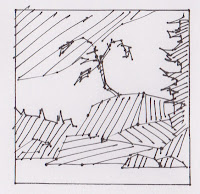Just finished a workshop with a group of energized and accomplished artists in Whistler - The Whistler Out of Bounds Artists.
What fun! It was held in one of the organizer's garage and worked well. Some started by 7 AM and continued until 9 PM. While it was not a "live in workshop" the extended hours gave us the opportunity to really get to know one another and the fact that the group were all friends and paint together gave them the confidence to relax, explore new approaches, and experiment. The energy in the room was contagious. Certainly the most fun and rewarding of any of my workshops so far- and once again, I probably came away having learned more from my "students" than they did from me.
 |
| The "demo starts " made during the workshop. Two small oils and four larger acrylic. Need now to see if I can turn them into "paintings". |
Interesting to me was that, in spite of the fact that they were all advanced learners of the craft of painting, many told me that they identified with my attempt to clarify the stages of development of the artist and my attempt to show that many developing artists, although advanced in some areas are less advanced in others and that it would help if they could identify and isolate their weak areas and focus their learning.
Coming from a science background in learning and teaching at the university level I found learning to paint very frustrating. Organizing it into learning streams helped me and I think would help others. I am in the process of creating a syllabus, or "learning to paint curriculum", with specific learning goals for developing artists that I hope will make the learning needs clearer.
Below are a few of the slides used for that discussion:
 |
| Stages most artists go through as they progress. Learning to paint is a big "head game" and knowing where you are in the journey can help. |
 |
| A few learning streams. Trying to position your learning in each may help to identify topics that need attention. |
A few comments from the workshop:
" ... can’t tell you how much I enjoyed the week. I’m feeling very inspired.
" You have incredible energy, generosity and kindness in your teaching."
" As a former teacher, I can say with authority that you're a very exceptional teacher"
" We all agree that was likely the best workshop we've ever had. It will take some time to assimilate and incorporate but we had SO much learning. It was perfect for our group.. loads of practical and technical information as well as constant repetition of fundamentals. And you were so willing to work hard with each one of us.
" You are a superb fun teacher .. "












